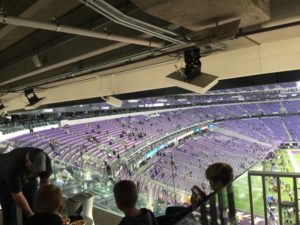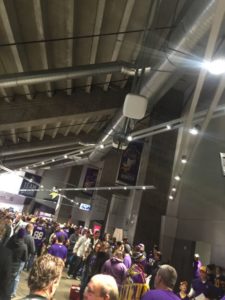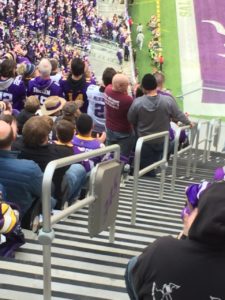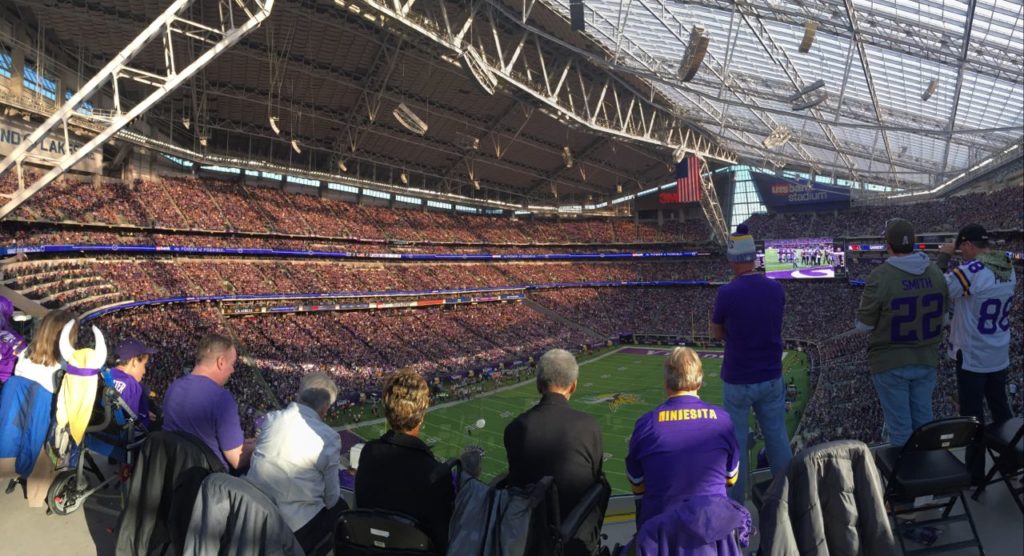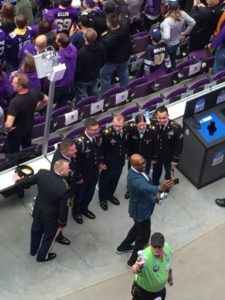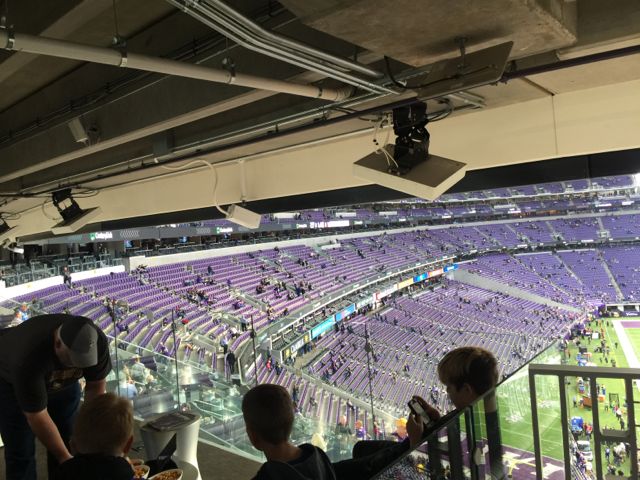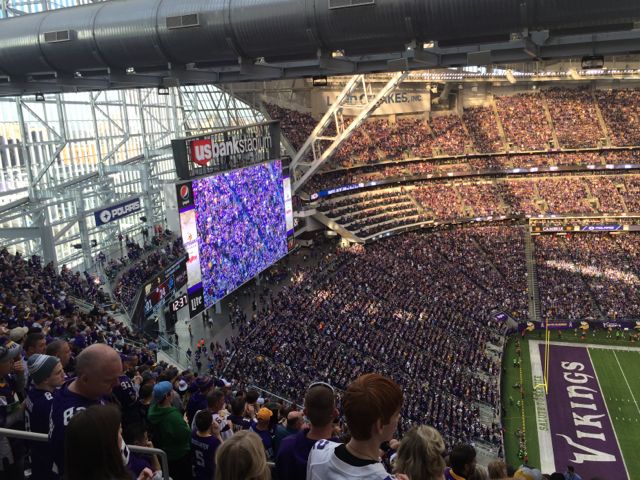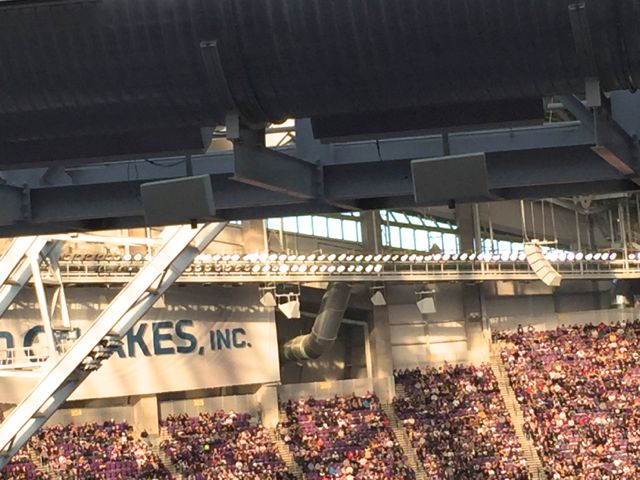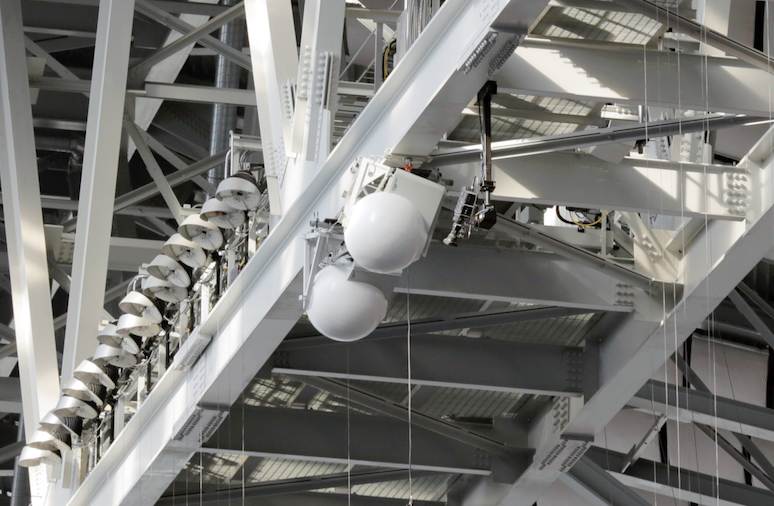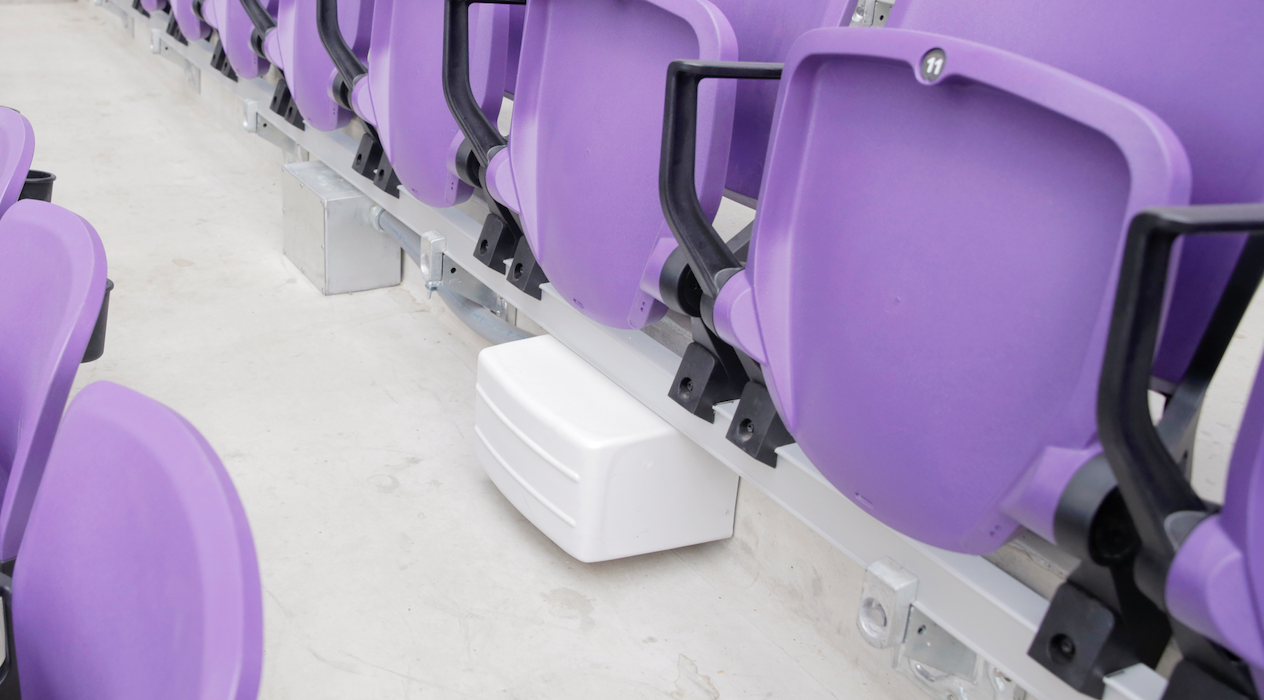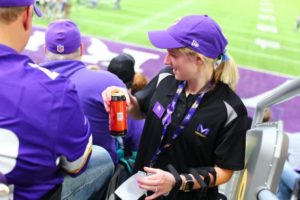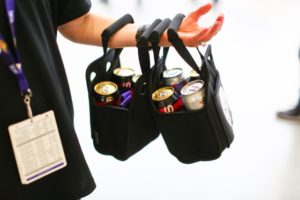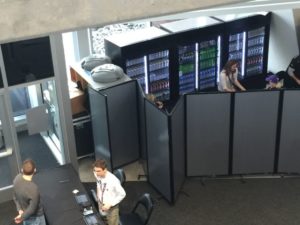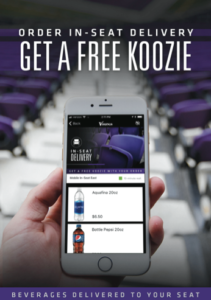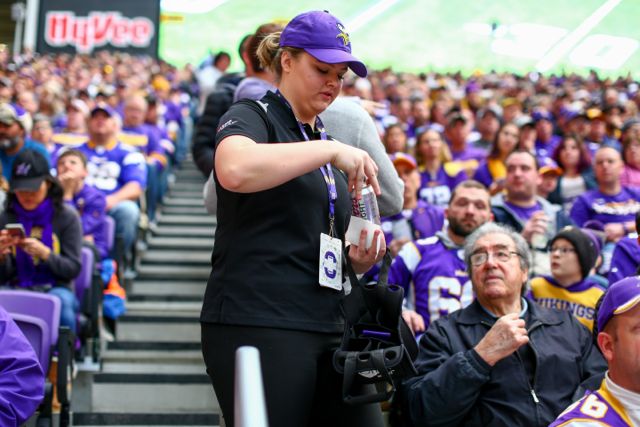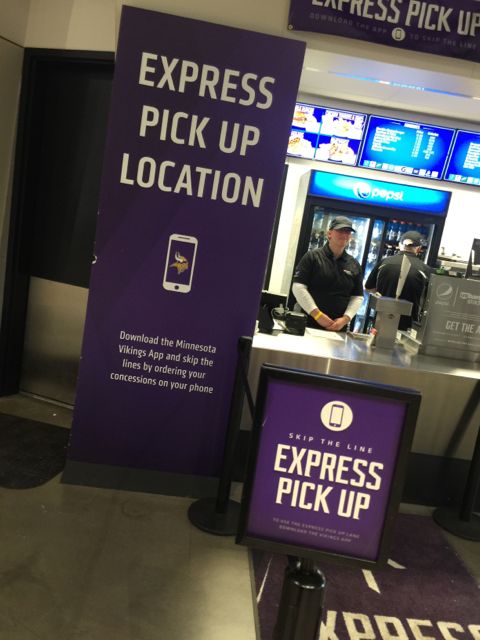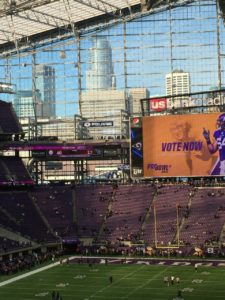
A look at downtown Minneapolis from inside U.S. Bank Stadium. Credit all photos: Paul Kapustka, MSR (click on any photo for a larger image)
But even if the hometown team falls short of making the big game this season, on Feb. 4, 2018 the stadium itself should do Minneapolis proud, especially when it comes to wireless connectivity. With two full regular seasons of football and numerous other events to test the networks’ capacity, both the Wi-Fi and DAS networks inside the 66,655-seat U.S. Bank Stadium appear more than ready to handle what is usually the highest single-day bandwidth stress test, namely the NFL’s yearly championship game. (Though the selfies and uploads following Sunday’s walk-off touchdown toss may have provided an early indicator of massive network use!)
In a mid-November visit to U.S. Bank Stadium for a Vikings home game against the Los Angeles Rams, Mobile Sports Report found robust coverage on both the Wi-Fi and cellular networks all around the inside of the stadium, with solid performance even amidst thick crowds of fans and even in the highest reaches of the seating bowl. Speedtests on the Wi-Fi network, built by AmpThink using Cisco gear, regularly hit marks of 40 to 50-plus Mbps in most areas, with one reading reaching 85 Mbps for download speeds.
And on the DAS side of things, Verizon Wireless, which built the neutral-host network inside U.S. Bank Stadium, said in December that it has already seen more cellular traffic on its network for a Vikings home game this season than it saw at NRG Stadium for Super Bowl LI last February. With 1,200 total antennas — approximately 300 of which were installed this past offseason — Verizon said it is ready to handle even double the traffic it saw at last year’s game, when it reported carrying 11 terabytes of data on stadium and surrounding macro networks.
Good connectivity right inside the doors
Editor’s note: This profile is from our most recent STADIUM TECH REPORT for Winter 2017-18, which is available for FREE DOWNLOAD from our site. This issue has an in-depth look at the wireless networks at U.S. Bank Stadium in Minneapolis, as well as profiles of network deployments at the brand-new Little Caesars Arena, the Las Vegas Convention Center, and Orlando City Stadium! DOWNLOAD YOUR FREE COPY today!
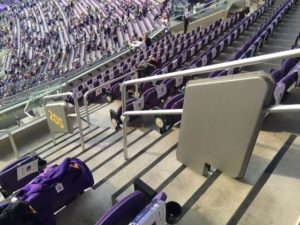
A new Verizon DAS antenna handrail enclosure (right) at U.S. Bank Stadium in Minneapolis. (The enclosure lower left is for Wi-Fi).
“You’re never really satisfied, because you want it to be the best it can be,” said Farstad in an interview during our November visit to Minneapolis. “But generally speaking, we’re very pleased with the state of the networks.”
Those networks are tested the very moment the Vikings open the doors for home games, especially in warmer weather when the signature big glass doors — five of them, all 55 feet wide and ranging in height from 75 to 95 feet — swing out to welcome fans. As the entry that points toward downtown, the west gate can account for as much as 70 percent of the fans arriving, according to the Vikings, putting a big crush on the wireless networks in the doorway area.
To help keep people connected in crowded situations, Verizon deployed extra DAS antennas on short poles in front of both the west and east end zone concourse areas, part of a 48 percent increase in overall DAS antenna numbers added during the football offseason. Even with thick crowds streaming into the stadium, we still got a DAS speedtest of 77.35 Mbps download and 32.40 Mbps upload on the concourse just inside the west doors, and just below the Gjallarhorn.
Walking around the main level concourse, connectivity hardware is easy to see if you know what you’re looking for; part of the extensive DAS coverage includes dual antennas hanging off a single pole above wide walkway segments. And in one instance, we saw a good example of aesthetic integration, with a Wi-Fi AP attached just behind two IPTV screens, with a beacon attached to the side and a DAS antenna mounted just above everything else.
First big test of railing-mounted Wi-Fi?
Moving into the seating bowl, visitors may not know that many of the Wi-Fi network’s 1,300 APs are hiding there in plain sight — inside silver handrail enclosures, many of which now sport bright, bold section numbers to help fans find their seats. Believed to be the first big football-sized stadium that relied mainly on railing-mounted APs, the proximate network design from AmpThink is proving to be a winner in performance, producing regular-season game data totals of around 3 terabytes per event and maybe more importantly, keeping an optimal number of fans attached to the AP closest to them for the speediest connection.
Sitting next to AmpThink president Bill Anderson in the stadium’s press box you get a great view of the field, but it’s doubtful Anderson watches much football action given that he spends most of a game day glued to a screen that shows live detailed performance for every Wi-Fi AP in the building. While the analytics program produces a wealth of interesting data, the one metric that keeps Anderson’s attention is the one showing how many fans are connected to each AP, a number that will be no more than 50 and ideally somewhere around 25 connections if the network is performing as it should be.On the day we visited, on Anderson’s screen there was one AP showing more than 200 devices trying to connect to it, an issue Anderson noted for immediate problem-solving. But with only a handful of others showing more than 50 connections, Anderson was confident that AmpThink has been able to figure out how to solve for the main dilemma for Wi-Fi in large enclosed structures, namely keeping APs from interfering with each
other. The large clear-plastic roof and wall areas at U.S. Bank Stadium don’t help, since they reflect RF signals to add to the network design degree of difficulty.
But the multiple railing-mount network design – which AmpThink duplicated at Notre Dame University, whose new network is seeing the highest-ever data totals seen at collegiate events – seems to be fulfilling AmpThink’s goal to produce networks with steady AP loads and consistent, high-density throughput in extremely challenging environments. The railing-mounted APs provide connectivity that couldn’t be delivered by overhead antennas, like in Notre Dame’s open concrete bowl and in U.S. Bank Stadium’s similar wide-open seating area, where no overhead structure is within 300 feet of a seat.
“I think we have a network strategy that produces good uniform performance” in venues like U.S. Bank Stadium, Anderson said. “It’s pretty darn exciting to have a formula that works.”More antennas get DAS ready for big game
And even though Verizon knew the Super Bowl was coming to U.S. Bank Stadium when it built the neutral host DAS for the 2016 opening, it came right back this past offseason and added approximately another 300 new antennas (mainly for its own use and not for the shared DAS), all in the name of unstoppable demand for mobile bandwidth from fans attending events.
Diana Scudder, executive director for network assurance at Verizon, said in a phone interview that “the consumer appetite [for wireless data] is insatiable,” especially at the NFL’s biggest game, where DAS use has grown at a fast clip the past few years. Scudder said these days Verizon pretty much plans to see double whatever the last Super Bowl saw for each following big game, and adds network capacity accordingly. Verizon’s numbers from the past three Super Bowls are a good guide, with the carrier reporting 4.1 TB used at Super Bowl 49, 7 TB at Super Bowl 50, and 11 TB at Super Bowl 51.
AmpThink’s handrail-mounted AP enclosures seem to have played a hand in part of Verizon’s DAS upgrade, as some of the new DAS enclosures seem to mimic the Wi-Fi ones with their smaller silver enclosures. Scudder did say that Verizon used contractors to assist with the new antenna deployment enclosures and mounts, but did not cite AmpThink by name. Verizon also deployed some under-seat antenna enclosures for its upgrade, a tactic the company also used for Super Bowl 50 at Levi’s Stadium in Santa Clara, Calif.
Even up in the most nosebleed of seats — in U.S. Bank Stadium’s case, section 345, which has seats almost touching the roof in the southwest corner, we got a DAS speedtest on the Verizon network of 60.87 Mbps / 44.22 Mbps, most likely from some antennas we could see mounted just above the seats on ventilation pipes a bit toward the field. And hanging from the middle of U.S. Bank Stadium’s roof are a pair of Matsing Ball antennas, which point down to provide cellular service for media and photographers on the sidelines, as well as for floor seating for concerts and other events.
Ready to add more bandwidth on the fly
Even less unseen and probably not appreciated until it’s needed is the stadium’s backbone bandwidth, provided by sponsoring partner CenturyLink.
Though some stadiums are touting 100 Gbps pipes coming in, the U.S. Bank Stadium setup makes the venue its own ISP, according to Farstad.With six 10-Gbps pipes that are always active — and on two separate network infrastructures for redundancy — the stadium can turn up its bandwidth on the fly, a test the venue got on its first public event.
According to Farstad, when U.S. Bank Stadium opened for the first time with a soccer game on Aug. 3, 2016, the stadium operators expected about 25,000 fans might show up for a clash between Chelsea and AC Milan. But a favorable newspaper article about the stadium led to more than 64,000 fans in the house, a surge that backed up the light-rail trains and saw the concession stands run out of food.
“We were watching the Wi-Fi system during the first break [in the soccer game] and it was coming down fast,” Farstad said. But the ability to increase capacity quickly — Farstad said that within 45 seconds, the stadium was able to provision new bandwidth, a task that in other situations could take weeks — the Wi-Fi survived the unexpected demands, proof that it should be able to handle whatever happens on Super Bowl Sunday.
“I think we can handle the Super Bowl traffic,” Farstad said.
